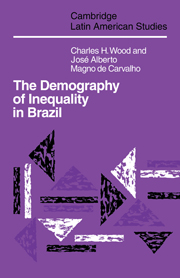Book contents
- Frontmatter
- Contents
- Illustrations
- List of tables
- Preface
- 1 Introduction
- 2 Framework for the study of population, development and inequality
- 3 Growth and distribution in historical perspective
- 4 Income inequality and length of life
- 5 Wage policy, infant mortality and collective social action in São Paulo
- 6 Racial inequality and child mortality
- 7 The “baby bust”
- 8 Income distribution and population growth
- 9 Agrarian structure and the rural exodus
- 10 Colonization and frontier expansion in Amazônia
- 11 Development and persistent underemployment
- 12 The demography of inequality in Brazil: summary and conclusion
- Appendix: A note on method
- Notes
- Bibliography
- Index
- CAMBRIDGE LATIN AMERICAN STUDIES
4 - Income inequality and length of life
Published online by Cambridge University Press: 04 August 2010
- Frontmatter
- Contents
- Illustrations
- List of tables
- Preface
- 1 Introduction
- 2 Framework for the study of population, development and inequality
- 3 Growth and distribution in historical perspective
- 4 Income inequality and length of life
- 5 Wage policy, infant mortality and collective social action in São Paulo
- 6 Racial inequality and child mortality
- 7 The “baby bust”
- 8 Income distribution and population growth
- 9 Agrarian structure and the rural exodus
- 10 Colonization and frontier expansion in Amazônia
- 11 Development and persistent underemployment
- 12 The demography of inequality in Brazil: summary and conclusion
- Appendix: A note on method
- Notes
- Bibliography
- Index
- CAMBRIDGE LATIN AMERICAN STUDIES
Summary
Mortality occupies a special place in demographic inventories of socioeconomic change. As a relatively sensitive indicator of the level and the distribution of living conditions, mortality bears a direct and obvious relationship to human welfare (United Nations 1980: 71). The mortality rate is the result of the interaction of three sets of factors that affect a population's wellbeing: public health services which influence mortality regardless of individual behavior (such as spraying insecticides that control malaria); health and environmental services that reduce the costs of health, but require some individual response (e.g., the availability of clean water); and an array of individual characteristics such as income, which affects health through nutrition and housing, and education, associated with the speed and the efficiency with which individuals respond to health services and environmental threats (Birdsail 1980: 16). Because the level of mortality is determined by the combined effect of all these factors, the death rate provides a summary measure of the quality of life that prevails in a population.
Newly developed demographic methods have greatly expanded the scope and the accuracy of mortality research. Traditional estimates of the death rate rely on vital registration statistics. The newer approach, developed by William Brass, measures mortality indirectly from survey or census data. In the Brass method, the proportion of children surviving to mothers in different age groups (20–4; 25–9 and 30–4), multiplied by the appropriate correction factor, yields estimates of the probability of death by exact ages 2, 3 and 5.
- Type
- Chapter
- Information
- The Demography of Inequality in Brazil , pp. 86 - 103Publisher: Cambridge University PressPrint publication year: 1988



